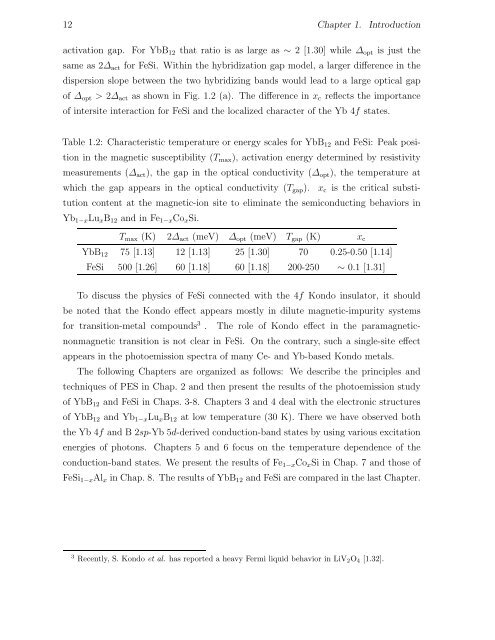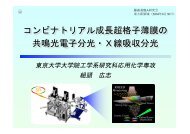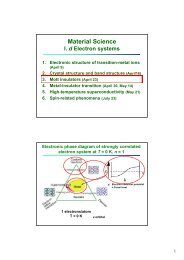Thesis High-Resolution Photoemission Study of Kondo Insulators ...
Thesis High-Resolution Photoemission Study of Kondo Insulators ...
Thesis High-Resolution Photoemission Study of Kondo Insulators ...
Create successful ePaper yourself
Turn your PDF publications into a flip-book with our unique Google optimized e-Paper software.
12 Chapter 1. Introduction<br />
activation gap. For YbB12 that ratio is as large as ∼ 2 [1.30] while ∆opt is just the<br />
same as 2∆act for FeSi. Within the hybridization gap model, a larger difference in the<br />
dispersion slope between the two hybridizing bands would lead to a large optical gap<br />
<strong>of</strong> ∆opt > 2∆act as shown in Fig. 1.2 (a). The difference in xc reflects the importance<br />
<strong>of</strong> intersite interaction for FeSi and the localized character <strong>of</strong> the Yb 4f states.<br />
Table 1.2: Characteristic temperature or energy scales for YbB12 and FeSi: Peak position<br />
in the magnetic susceptibility (Tmax), activation energy determined by resistivity<br />
measurements (∆act), the gap in the optical conductivity (∆opt), the temperature at<br />
which the gap appears in the optical conductivity (Tgap). xc is the critical substi-<br />
tution content at the magnetic-ion site to eliminate the semiconducting behaviors in<br />
Yb1−xLuxB12 and in Fe1−xCoxSi.<br />
Tmax (K) 2∆act (meV) ∆opt (meV) Tgap (K) xc<br />
YbB12 75 [1.13] 12 [1.13] 25 [1.30] 70 0.25-0.50 [1.14]<br />
FeSi 500 [1.26] 60 [1.18] 60 [1.18] 200-250 ∼ 0.1 [1.31]<br />
To discuss the physics <strong>of</strong> FeSi connected with the 4f <strong>Kondo</strong> insulator, it should<br />
be noted that the <strong>Kondo</strong> effect appears mostly in dilute magnetic-impurity systems<br />
for transition-metal compounds3 . The role <strong>of</strong> <strong>Kondo</strong> effect in the paramagneticnonmagnetic<br />
transition is not clear in FeSi. On the contrary, such a single-site effect<br />
appears in the photoemission spectra <strong>of</strong> many Ce- and Yb-based <strong>Kondo</strong> metals.<br />
The following Chapters are organized as follows: We describe the principles and<br />
techniques <strong>of</strong> PES in Chap. 2 and then present the results <strong>of</strong> the photoemission study<br />
<strong>of</strong> YbB12 and FeSi in Chaps. 3-8. Chapters 3 and 4 deal with the electronic structures<br />
<strong>of</strong> YbB12 and Yb1−xLuxB12 at low temperature (30 K). There we have observed both<br />
the Yb 4f and B 2sp-Yb 5d-derived conduction-band states by using various excitation<br />
energies <strong>of</strong> photons. Chapters 5 and 6 focus on the temperature dependence <strong>of</strong> the<br />
conduction-band states. We present the results <strong>of</strong> Fe1−xCoxSi in Chap. 7 and those <strong>of</strong><br />
FeSi1−xAlx in Chap. 8. The results <strong>of</strong> YbB12 and FeSi are compared in the last Chapter.<br />
3 Recently, S. <strong>Kondo</strong> et al. has reported a heavy Fermi liquid behavior in LiV2O4 [1.32].






